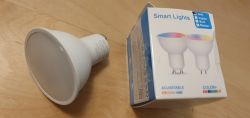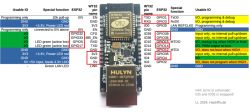FAQ
TL;DR: Nextion 7-inch 800×480 HMI is a pragmatic choice — “just connect the ESP over Serial and you're done.” Add a TCP/Serial bridge for wireless control and design the UI in the editor. [Elektroda, Slawek K., post #19406018]
Why it matters: This FAQ helps DIYers pick a reliable, wall-friendly ESP display for thermostats and status without forcing phone apps.
Quick Facts
- Nextion 7" 800×480 HMI uses simple RX/TX serial, has its own MCU, and can be driven over a TCP/Serial bridge. [Elektroda, Slawek K., post #19406018]
- Espressif ESP32-S2-HMI-DevKit-1 offers a 480×800 touch display on an official evaluation board. [Elektroda, khoam, post #19405984]
- Riverdi 5" IoT panels integrate an ESP32 on-board and are available locally in Poland. [Elektroda, khoam, post #19134118]
- A repurposed tablet with Chrome “pinned” to a web app works well; the app may close once every few weeks. [Elektroda, krzbor, post #19406154]
- Expect declared lifetimes of ~1–2 years with up to 50% brightness drop; design for replaceable matrix/backlight. [Elektroda, Ondo, post #19406531]
What’s the best 5–10 inch ESP-based wall display option right now?
There isn’t a common off‑the‑shelf 5–10" display with an ESP on the back. The closest is Nextion HMI. It’s not cheap, so many builders instead wall‑mount a low‑cost Android tablet and use a web UI. This balances price, size, and ease of deployment. [Elektroda, xury, post #19133214]
How do I wire an ESP8266/ESP32 to a Nextion HMI?
Use RX and TX for a direct serial link. “Just connect the ESP over Serial and you’re done.” You can also run a TCP/Serial bridge on the ESP to send data wirelessly to the screen. Nextion’s onboard MCU handles UI logic, reducing ESP code. [Elektroda, Slawek K., post #19406018]
Why pick Nextion instead of an FT8xx SPI panel?
Nextion adds an onboard microcontroller and editor, so UI runs locally. The connection is just serial, which simplifies wiring and firmware. The price gap versus FT8xx isn’t large, so the integration savings can outweigh parts cost in many builds. [Elektroda, Slawek K., post #19406018]
How can I use an FT8xx LCD with an ESP over SPI?
Buy a display with a front bezel and an FT8xx controller. Drive it via SPI from the ESP. This gives you flexibility and a clean front panel, but you handle graphics and touch in your firmware. [Elektroda, krzysiek_krm, post #19133898]
Is there an official ESP32 touch HMI devkit I can buy?
Yes. Espressif announced the ESP32‑S2‑HMI‑DevKit‑1, featuring a 480×800 touch display. It’s designed for fast UX prototyping with ESP32‑S2 and provides a supported reference platform. [Elektroda, khoam, post #19405984]
Can I get a ready 5-inch ESP32 display module locally?
Yes. Riverdi offers 5" panels that integrate an ESP32 module. They are sold as panel units and available in Poland, making sourcing and support easier for EU builders. [Elektroda, khoam, post #19134118]
Should I just repurpose a tablet for my smart‑home UI?
It’s a proven path. Mount a tablet in a wall frame, run Chrome, and pin your web app to the start screen. Serve the UI from a PC, Raspberry Pi, or similar; build it with HTML+JS. The app may close once every few weeks, but relaunching is one tap. [Elektroda, krzbor, post #19406154]
Will OLED phones burn in as wall panels?
Avoid OLED for always‑on or long‑display scenarios. Use LCD‑based tablets or phones instead. OLED panels don’t tolerate prolonged static content well, which makes them poor choices for fixed dashboards. [Elektroda, krzbor, post #19406154]
How do I mount a tablet cleanly on the wall?
Buy a case, remove everything but the front frame, and screw that frame to the wall. Drop the tablet into the frame for a tidy, serviceable installation that hides edges and cables. [Elektroda, krzbor, post #19406154]
Can I auto‑wake a wall tablet with motion?
Yes. One approach is using a PIR to momentarily cut and restore power, which wakes the tablet. Expect a wake delay around 2–3 seconds with this method. [Elektroda, krzbor, post #19406675]
Do smart‑home panels need to be readable 24/7 at full brightness?
No. Typical practice is wake‑on‑touch or automatic dimming/brightening using a light sensor or astronomical clock. Full brightness overnight is unnecessary. Also, no device runs indefinitely without power or maintenance. [Elektroda, Slawek K., post #19406777]
What about lifespan, brightness drop, and hardware availability?
Plan for aging. Some manufacturers declare 1–2 years of life with up to 50% brightness reduction. Whole modules may become unavailable, so prefer designs where the matrix or backlight can be replaced. Tablets also raise concerns like swollen batteries and weak micro‑USB power. [Elektroda, Ondo, post #19406531]
Can I avoid a built‑in display to sidestep aging issues?
Yes. Keep physical feedback minimal, for example with LEDs, and move visualization to phones or tablets via Wi‑Fi. This avoids flush‑mount cutout lock‑in and future overhauls if panels change size. [Elektroda, khoam, post #19406584]
Quick setup: Nextion + ESP in three steps
- Wire Nextion TX→ESP RX and Nextion RX→ESP TX.
- Design the UI in the Nextion editor and upload it.
- Send serial commands from the ESP, or add a TCP/Serial bridge for wireless updates. [Elektroda, Slawek K., post #19406018]
Is Nextion worth it if I’m moving to Home Assistant?
If you centralize control in Home Assistant, a dedicated Nextion panel can become redundant. Builders report dropping small Nextion setups after migrating interfaces into HA, given cost and overlapping functionality. [Elektroda, pitron, post #19620944]
Where can I buy Nextion screens and enclosures?
Vendors like elty.pl carry Nextion panels. You can get versions with enclosures or save by buying the bare display. Some makers also print or build custom housings for a tailored fit and finish. [Elektroda, Slawek K., post #19406018]








